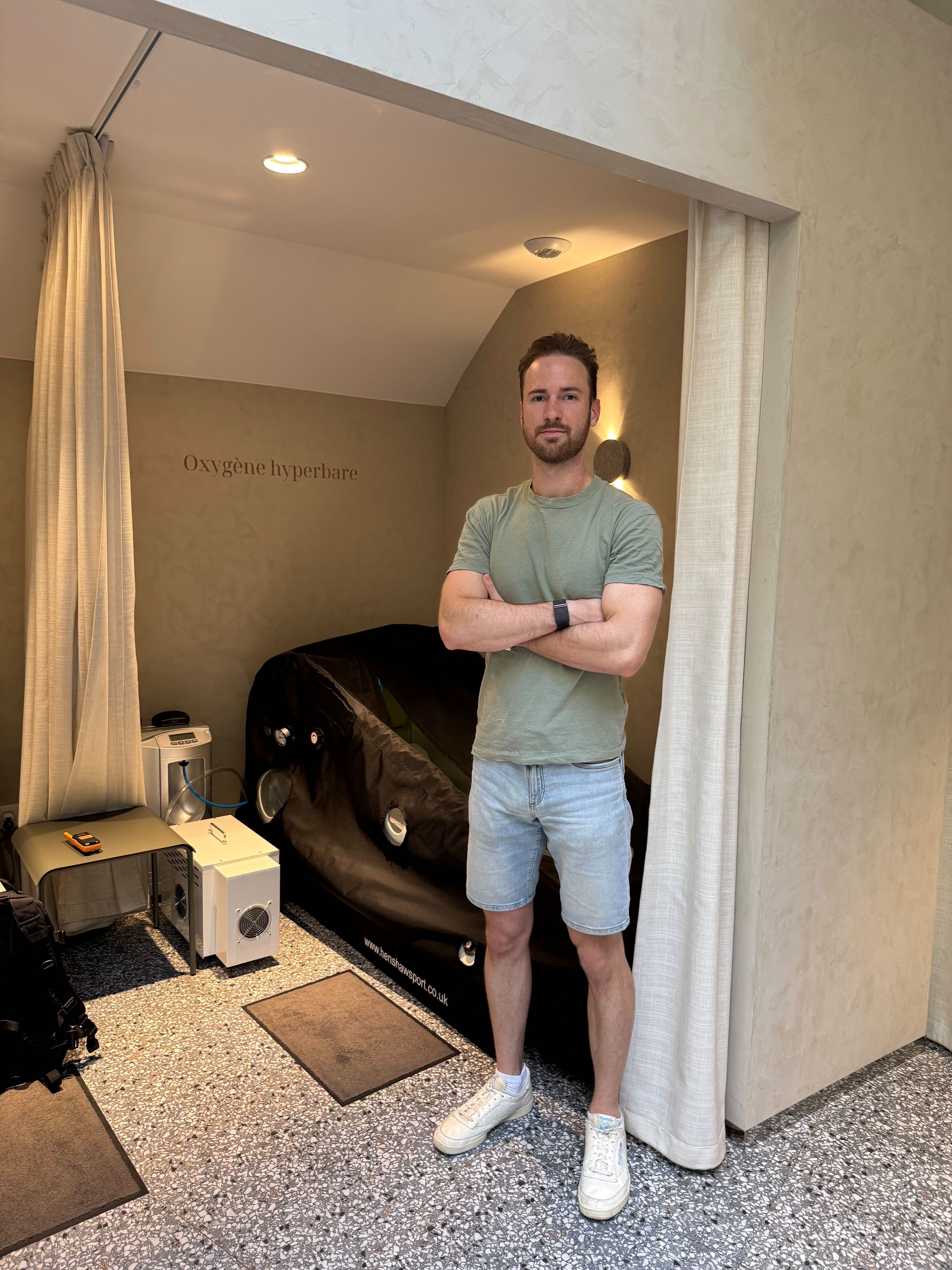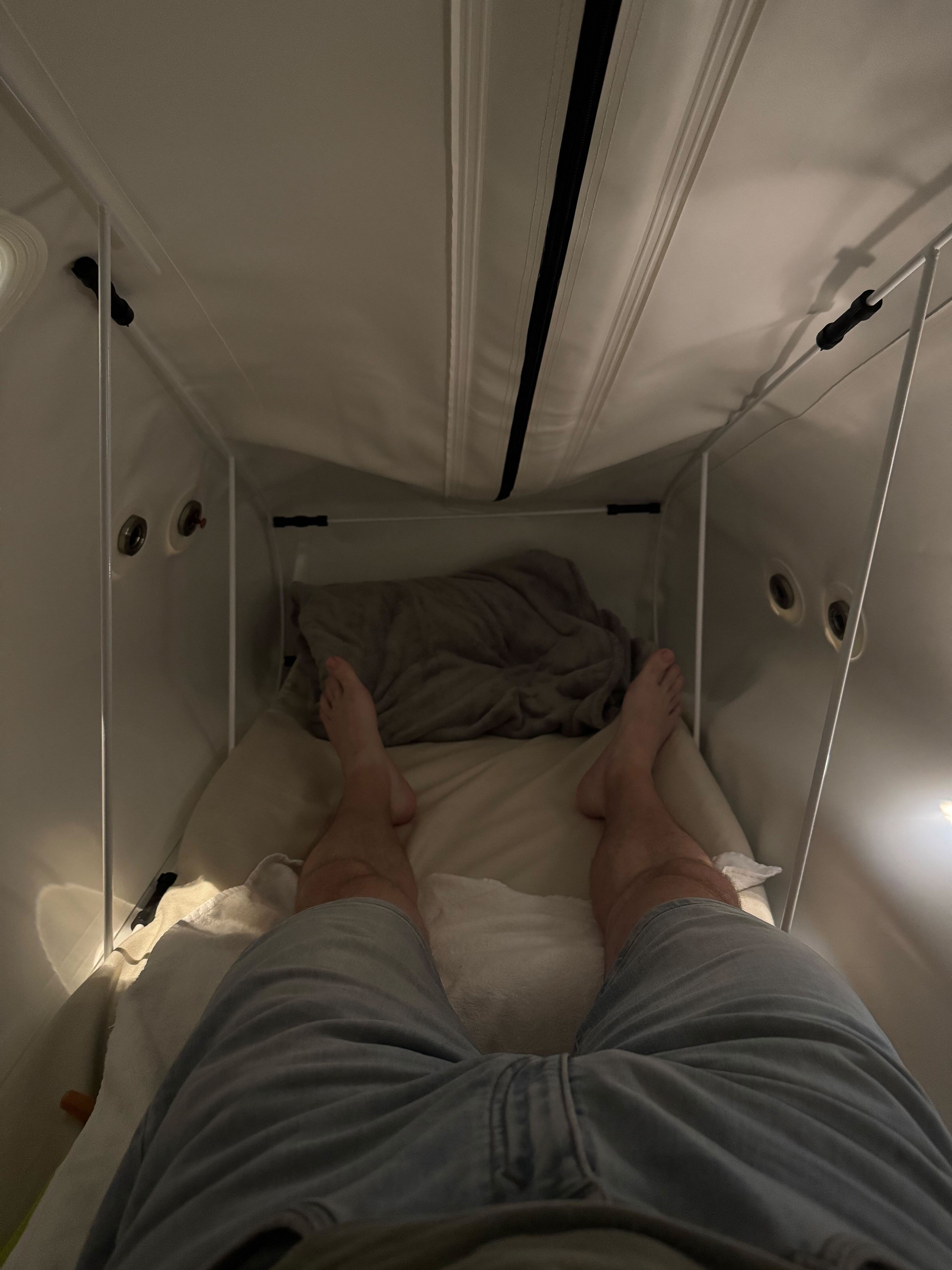At its core, Hyperbaric Oxygenation Therapy (HBOT) is about oxygen, delivered in a way the body’s never experienced before.
Here’s how it works: you enter a hyperbaric chamber (either hard shell or soft) and the pressure is increased, usually to somewhere between 1.3 and 3.0 ATA (Atmospheres Absolute). For context, 1.0 ATA is sea level. At 2.0 ATA, it’s like diving down 30+ feet underwater, but you’re just lying there, relaxed and breathing 100% oxygen.
That pressure matters. Under this kind of pressure, the body absorbs dramatically more oxygen, not just through red blood cells but also directly into plasma, lymphatic system, cerebrospinal fluid and all tissues of the organism. This is key: under higher pressure, oxygen dissolves not just into red blood cells but directly into plasma, lymph and other fluids (a process that isn’t possible under normal conditions). This means tissues that are typically oxygen-deprived (like injured muscles, inflamed nerves, poorly perfused brain areas, …) can receive a surge of oxygen to kickstart healing and regeneration. The higher the ATA, the deeper the oxygen penetration, though protocols vary depending on the goal (recovery vs brain healing vs anti-aging). Some sessions use pure oxygen (the one I’m doing), while others use compressed air with oxygen masks. In a typical session (60 to 90 minutes), the body becomes super-saturated with oxygen.

Why should you care?
Because oxygen is fuel. It’s the raw material our cells need to produce energy, repair damage but also fight off inflammation. And when we flood the body with oxygen under pressure, some incredible things happen.
Now, some of you might be thinking: “Hold on, doesn’t too much oxygen lead to oxidative stress and free radicals?” Great point. That’s the oxygen paradox. While it’s true that oxygen can generate reactive oxygen species (ROS) (which, in excess, can damage cells), it’s also true that small, controlled doses of ROS trigger the body’s own repair mechanisms. This is a classic example of hormesis: the idea that a little stress makes the system stronger.
HBOT works by creating a short, controlled burst of oxidative stress (what doesn’t kill you makes you stronger). It ramps up antioxidant defenses and stimulates cellular repair. It’s the same principle behind cold plunges, sauna use, intermittent fasting, exercise and even plant toxins, all mild stressors that lead to long-term resilience. With HBOT, you’re leveraging oxygen not just as fuel, but as a signal to adapt and upgrade.
Accelerated recovery for athletes
If you train hard, you’ve likely dealt with muscle soreness caused by inflammation, maybe even injury. HBOT helps muscles recover faster by different mechanisms: improving blood flow, reducing inflammation and stimulating angiogenesis (the formation of new blood vessels). Think of it like giving your whole recovery process a turbo boost.
I’ve personally found that even after brutal workouts or long training days, a session in the chamber helps my body bounce back way faster than rest alone. After a single session, DOMS (Delayed Onset Muscle Soreness) are non-existing.
Boosted energy and cognitive performance
Mitochondria (the energy factories in our cells) love oxygen. More oxygen means more ATP, which translates to better endurance, more strength, sharper mental clarity.
I’ve had HBOT sessions before intense work sprints while training hard at the same time, and the mental clarity/calm it brings is borderline addictive. You’re alert, focused, but not jittery (not like caffeine or nicotine).
Indeed, one of HBOT’s most impressive frontiers is neurological regeneration. Studies have shown that oxygen therapy can enhance neuroplasticity, as well as restore damaged neurons, which could improve cognitive function (especially in people dealing with cognitive issues such as brain fog following concussion or some kind of disease). For healthy individuals, it may support focus and memory, more particularly during periods of high stress. By increasing cerebral blood flow in the brain, HBOT provides a cognitive edge without relying on stimulants/nootropics.
Reversal of inflammation and chronic pain
Chronic inflammation is at the root of so many modern diseases (autoimmune issues, neurodegenerative diseases, cardiovascular problems); HBOT helps by reducing systemic inflammation while promoting tissue regeneration.
Some clinics now use HBOT as part of protocols to treat Lyme disease, long COVID, fibromyalgia, even neurodegenerative disease such as Alzheimer.
Longevity and anti-aging
Here’s where it gets really interesting: HBOT isn’t just about healing, it’s about reversing the biological clock.
Groundbreaking research from Dr. Shai Efrati showed that consistent HBOT treatments could lengthen telomeres and reduce senescent cells (or “zombie cells”).
Dr. Efrati’s study had participants undergo 60 sessions of HBOT over 3 months, breathing pure oxygen at 2.0 ATA for 90 minutes a day, five days a week. The results?
- Telomere length increased by 20–38% (depending on cell type)
- Senescent cells decreased by up to 37%
Those are numbers we rarely see outside of speculative gene therapies. Even more interesting: the improvements weren’t just lab numbers. Many participants experienced more energy in the short time and improved quality of life in the long time. This positions HBOT not just as a healing modality, but as a serious anti-aging and longevity intervention.
HBOT and the longevity movement
Visionaries like Peter Diamandis (co-founder of Singularity University and founder of the XPRIZE) are also major advocates of HBOT. Diamandis sees HBOT as a critical component of the growing field of longevity and human optimization.
He’s backed companies developing next-gen HBOT systems and even incorporates it into his own wellness regimen.
HBOT is now being discussed alongside fasting, NAD+ boosting compounds, cryotherapy and stem cells as a core pillar of regenerative medicine.
My personal experience
Could just sitting in a pressurized tube really do all this? So I tried it.

After a few sessions, I noticed a big shift. My workouts felt smoother. My sleep deepened. Muscle soreness vanished. I had more energy, more focus and a weird sense of resilience, like my body was more ready.
Over time, HBOT has become a non-negotiable part of my routine. Not just for recovery, but as an investment in my future self.
Is HBOT right for you?
If you’re:
- Training hard and want faster recovery
- Had a severe injury and want to heal
- Suffer from inflammation and chronic pain
- Looking to optimize your energy levels
- Exploring longevity strategies to extend healthspan
Then yes, it might be. Of course, HBOT isn’t a cure-all. And it’s not for everyone (⚠️ if you have untreated pneumothorax, certain lung issues or other contraindications, you’ll want to consult a specialist first).
But for many, it’s one of the most powerful yet underutilized tools in the performance enhancing or longevity toolbox.
Final thoughts
We often chase new supplements, expensive treatments, and exotic biohacks. But sometimes, the most powerful healing tool is the one we’ve always had access to: oxygen. HBOT simply amplifies it.
To me, HBOT isn’t just therapy, it’s strategy. It’s about working with biology instead of against it, leveraging science to recover faster and maybe turn back the clock.
If you’re curious to try it or want to talk more about how to integrate it into your life, feel free to reach out. I’d love to share recommendations.